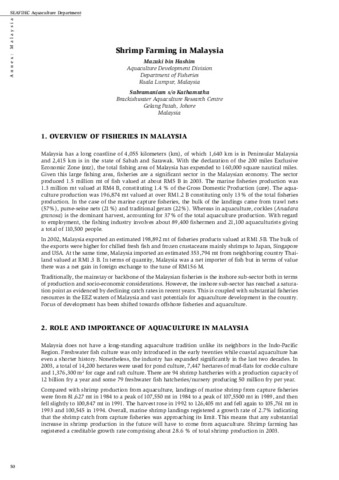Shrimp farming in Malaysia
| dc.contributor.author | bin Hashim, Mazuki | |
| dc.contributor.author | Kathamuthu, Subramanian | |
| dc.date.accessioned | 2012-02-11T14:02:07Z | |
| dc.date.available | 2012-02-11T14:02:07Z | |
| dc.date.issued | 2005 | |
| dc.identifier.citation | Hashim, M. & Kathamuthu, S. (2005). Shrimp farming in Malaysia. In: Regional Technical Consultation on the Aquaculture of P. vannamei and Other Exotic Shrimps in Southeast Asia, Manila, Philippines (pp. 50-56). Tigbauan, Iloilo, Philippines : SEAFDEC Aquaculture Department. | en |
| dc.identifier.uri | http://hdl.handle.net/10862/851 | |
| dc.description.abstract | Malaysia has a long coastline of 4,055 kilometers (km), of which 1,640 km is in Peninsular Malaysia and 2,415 km is in the state of Sabah and Sarawak. With the declaration of the 200 miles Exclusive Economic Zone (EEZ), the total fishing area of Malaysia has expended to 160,000 square nautical miles. Given this large fishing area, fisheries are a significant sector in the Malaysian economy. The sector produced 1.5 million mt of fish valued at about RM5 B in 2003. The marine fisheries production was 1.3 million mt valued at RM4 B, constituting 1.4 % of the Gross Domestic Production (GDP). The aquaculture production was 196,874 mt valued at over RM1.2 B constituting only 13% of the total fisheries production. In the case of the marine capture fisheries, the bulk of the landings came from trawl nets (57%), purse-seine nets (21%) and traditional gerars (22%). Whereas in aquaculture, cockles (Anadara granosa) is the dominant harvest, accounting for 37% of the total aquaculture production. With regard to employment, the fishing industry involves about 89,400 fishermen and 21,100 aquaculturists giving a total of 110,500 people. In 2002, Malaysia exported an estimated 198,892 mt of fisheries products valued at RM1.5B. The bulk of the exports were higher for chilled fresh fish and frozen crustaceans mainly shrimps to Japan, Singapore and USA. At the same time, Malaysia imported an estimated 353,794 mt from neighboring country Thailand valued at RM1.3 B. In terms of quantity, Malaysia was a net importer of fish but in terms of value there was a net gain in foreign exchange to the tune of RM156 M. Traditionally, the mainstay or backbone of the Malaysian fisheries is the inshore sub-sector both in terms of production and socio-economic considerations. However, the inshore sub-sector has reached a saturation point as evidenced by declining catch rates in recent years. This is coupled with substantial fisheries resources in the EEZ waters of Malaysia and vast potentials for aquaculture development in the country. Focus of development has been shifted towards offshore fisheries and aquaculture. | en |
| dc.language.iso | en | en |
| dc.publisher | Aquaculture Department, Southeast Asian Fisheries Development Center | en |
| dc.title | Shrimp farming in Malaysia | en |
| dc.type | Meeting report | en |


